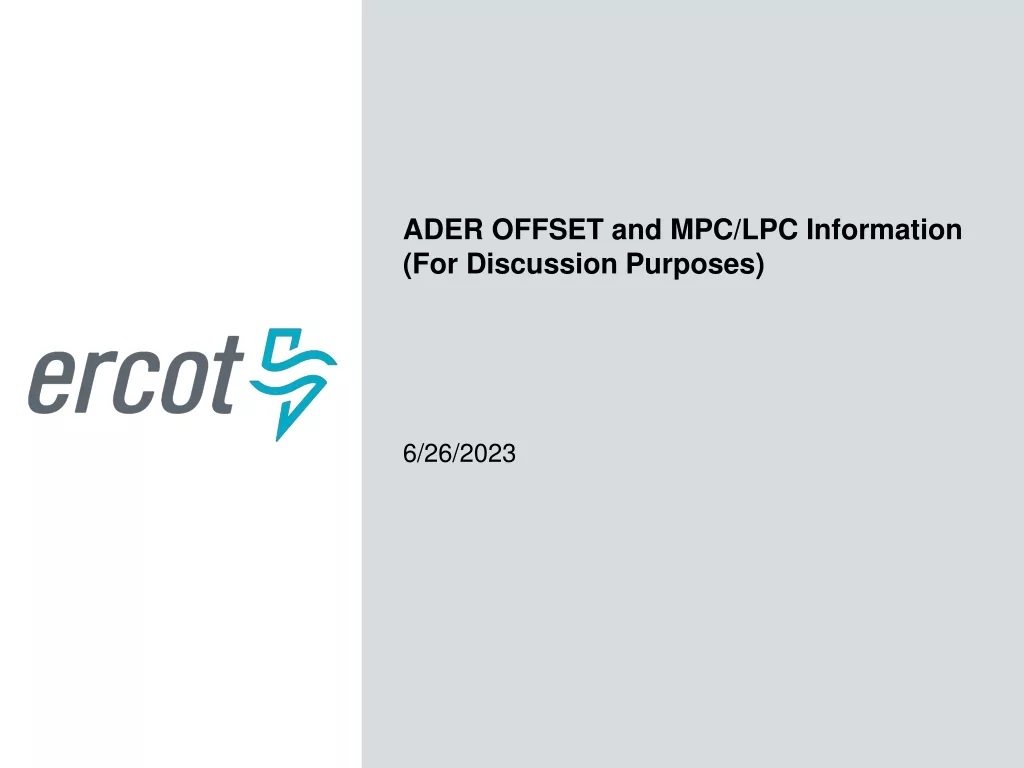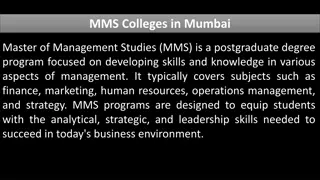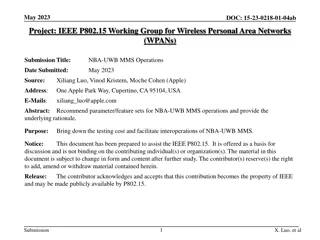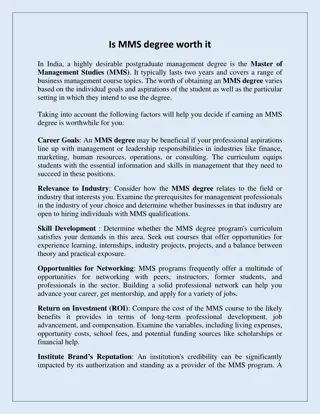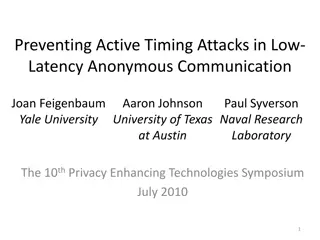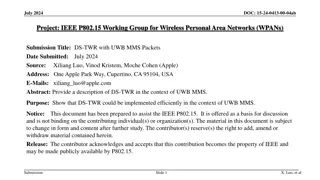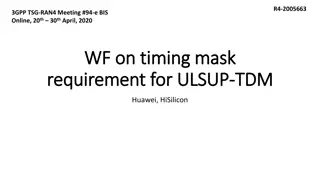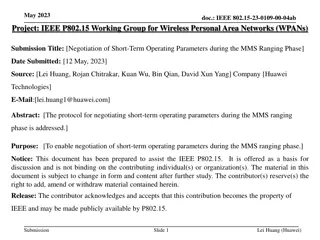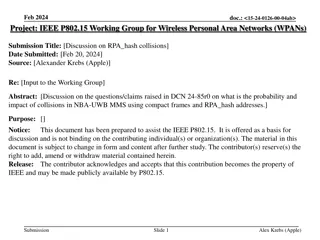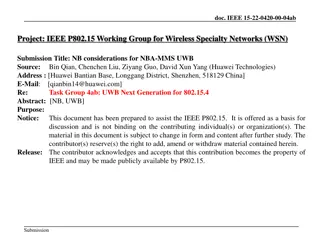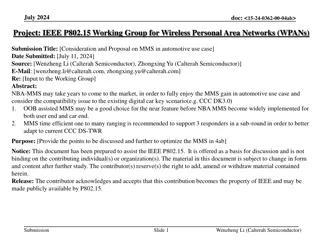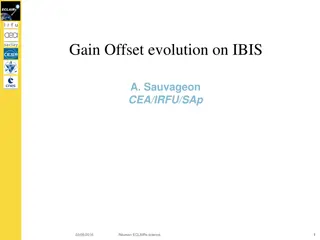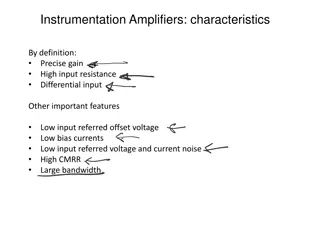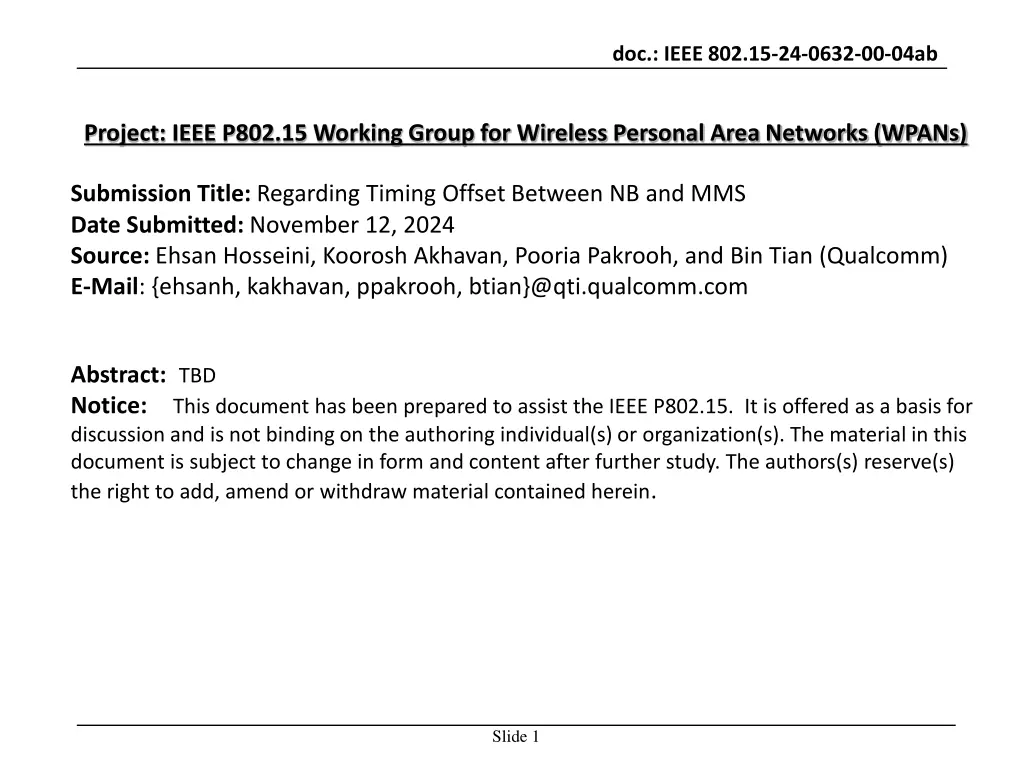
IEEE 802.15-24-0632-00-04ab Project: Timing Offset Between NB and MMS
Explore the detailed submission regarding timing offset considerations between NB and MMS in IEEE 802.15 standard for Wireless Personal Area Networks (WPANs). The document discusses clock synchronization, transmission calibration, CIR estimation, and recommendations for limiting timing errors in UWB receivers. Read on for insights into CIR windows, design constraints, and interoperability suggestions.
Download Presentation

Please find below an Image/Link to download the presentation.
The content on the website is provided AS IS for your information and personal use only. It may not be sold, licensed, or shared on other websites without obtaining consent from the author. If you encounter any issues during the download, it is possible that the publisher has removed the file from their server.
You are allowed to download the files provided on this website for personal or commercial use, subject to the condition that they are used lawfully. All files are the property of their respective owners.
The content on the website is provided AS IS for your information and personal use only. It may not be sold, licensed, or shared on other websites without obtaining consent from the author.
E N D
Presentation Transcript
doc.: IEEE 802.15-24-0632-00-04ab Project: IEEE P802.15 Working Group for Wireless Personal Area Networks (WPANs) Submission Title: Regarding Timing Offset Between NB and MMS Date Submitted: November 12, 2024 Source: Ehsan Hosseini, Koorosh Akhavan, Pooria Pakrooh, and Bin Tian (Qualcomm) E-Mail: {ehsanh, kakhavan, ppakrooh, btian}@qti.qualcomm.com Abstract:TBD Notice:This document has been prepared to assist the IEEE P802.15. It is offered as a basis for discussion and is not binding on the authoring individual(s) or organization(s). The material in this document is subject to change in form and content after further study. The authors(s) reserve(s) the right to add, amend or withdraw material contained herein. Slide 1
doc.: IEEE 802.15-24-0632-00-04ab Introduction According to 15.ab standard, O-QPSK PHY is expected to share a common clock source with the UWB PHY to determine the clock offset (A) to assist the MMS accumulation Slide 2
doc.: IEEE 802.15-24-0632-00-04ab Introduction While there is specification on the values of ?in the 15.4ab, there is no specification on the tolerance of ? Slide 3
doc.: IEEE 802.15-24-0632-00-04ab Tx Calibration At the Tx, the NB signal and UWB signal go through two different Tx paths, e.g., two different Radios. Even with timing calibration between NB and UWB at the Tx antenna, the timing offset ? is subject to error, ??. CIR Window CIR estimation is the primary operation that enables ToA estimation. Due to Rx NB timing error ?? caused by channel delay spread, noise and other impairments, the UWB receiver needs to estimate the CIR over a uncertainty window ??, to ensure first path and strong path falls in the window. Slide 4
doc.: IEEE 802.15-24-0632-00-04ab CIR Window ? ?? UWB RSF1 Tx NB packet ToF ToF ToF ToF UWB RSF1 Rx NB Packet ??+ ?? ? ? ? : Parameter specifies the minimum CIR span to capture ??/2 ??/2 ?? physical channel physical channel ??/2 > max ?? + max ?? + ?
doc.: IEEE 802.15-24-0632-00-04ab Discussion The total timing error between the transmitted UWB fragment and its expected arrival time at Rx should fit in the CIR window ??. At Rx, we must have ?? 2> max ?? + max ?? + ? Although ??is a design parameter, it cannot arbitrarily grow. We recommend defining a constraint on ?? to limit design complexity of the NBA-MMS UWB receivers and guarantee interoperability between devices Slide 6
doc.: IEEE 802.15-24-0632-00-04ab Numerical examples Here we have computed limits on ?? for some examples based on some design choices for ?? as well as assumptions on ?? max ?? + ? = max ?? = 0 25 chips 50 chips 75 chips 100 chips 125 chips 150 chips 125 chips 62 chips 37 chips 12 chips ?? ?? ?? ?A 250 chips 125 chips 100 chips 75 chips 50 chips 25 chips 0 chips ?? ??= 500 chips 250 chips 225 chips 200 chips 175 chips 150 chips 125 chips 100 chips 1000 chips 500 chips 475 chips 450 chips 425 chips 400 chips 375 chips 350 chips Slide 7
doc.: IEEE 802.15-24-0632-00-04ab Start-of-signal definition We need a clear definition of Tx Start-of-Signal (SoS) for OQPSK and UWB. The SoS for UWB fragments can be defined to be the peak of the first chip. The SoS for OQPSK can be defined based on the baseband I/Q signal such as the red arrow shown below. SoS Slide 8


